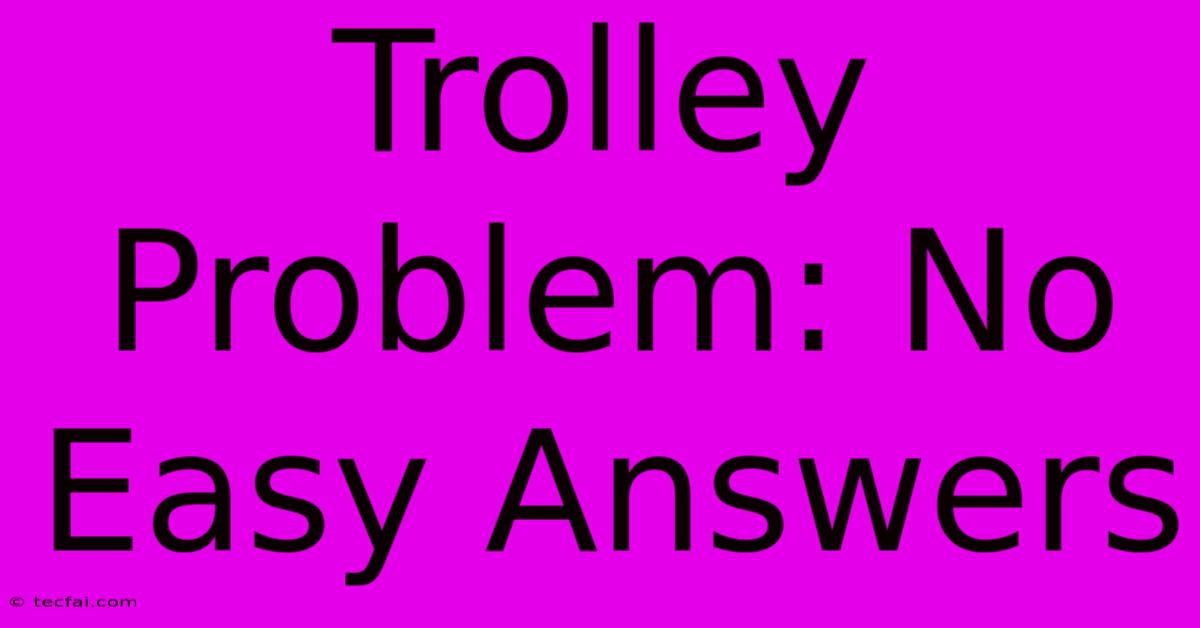Trolley Problem: No Easy Answers

Discover more detailed and exciting information on our website. Click the link below to start your adventure: Visit Best Website tecfai.com. Don't miss out!
Table of Contents
Trolley Problem: No Easy Answers
The Trolley Problem. A seemingly simple thought experiment, yet it's a philosophical minefield that has captivated ethicists, psychologists, and even the general public for decades. Its enduring power lies in its ability to expose the complexities of moral decision-making and highlight the often-conflicting principles we navigate in life-or-death situations. This article delves into the Trolley Problem, exploring its variations, the ethical frameworks it challenges, and why it continues to offer no easy answers.
Understanding the Classic Trolley Problem
The classic scenario typically presents a runaway trolley hurtling down the tracks towards five people tied to the rails. You, a bystander, have the power to pull a lever, diverting the trolley onto a side track where only one person is tied. Do you pull the lever, sacrificing one life to save five?
This seemingly straightforward choice unravels into a complex web of ethical considerations. The core dilemma pits consequentialism (focusing on the outcome – saving the most lives) against deontology (emphasizing moral duties and rules – the inherent wrongness of actively causing harm). Pulling the lever actively causes the death of one person, even if it saves others. Not pulling it allows the trolley to continue its course, resulting in five deaths, but you remain passively involved.
Variations on a Theme: Expanding the Ethical Landscape
The original Trolley Problem's impact has led to countless variations, each designed to tweak the parameters and explore different facets of moral reasoning. These variations often introduce nuances that complicate the decision-making process further. For example:
The Fat Man Variation:
This variation replaces the lever with a large person standing on a bridge overlooking the tracks. Pushing this person onto the tracks would stop the trolley, saving the five tied to the rails. This shifts the focus from passive observation to active participation in causing someone's death, making the moral implications even weightier for many.
The Transplant Problem:
This variation moves beyond the physical to the medical realm. A healthy individual's organs could save the lives of five patients needing transplants. Would it be morally justifiable to kill the healthy individual to save the five? This highlights the significant differences between killing and letting die.
These variations emphasize the lack of a universally accepted solution and underscore the situational and subjective nature of moral judgment.
Ethical Frameworks and the Trolley Problem: A Clash of Ideals
The Trolley Problem challenges various ethical frameworks, including:
- Utilitarianism: This philosophy suggests the best action is the one that maximizes overall happiness and minimizes suffering. A utilitarian would likely pull the lever in the classic scenario, saving the greater number of lives.
- Deontology: This approach emphasizes moral duties and rules, irrespective of consequences. A deontological perspective might argue against pulling the lever, as it involves actively causing the death of an innocent person.
- Virtue Ethics: This focuses on character and moral virtues. This approach emphasizes the character traits a moral agent should cultivate, such as compassion and justice, to guide decision-making in such situations.
The Trolley Problem highlights the limitations and potential conflicts between these different ethical frameworks, showcasing the lack of a singular, universally applicable ethical compass.
Why the Trolley Problem Remains Relevant
The Trolley Problem isn't merely an academic exercise. It serves as a valuable tool for:
- Exploring moral reasoning: It forces us to confront our own moral intuitions and critically examine the basis of our ethical judgments.
- Understanding decision-making under pressure: The high-stakes nature of the scenario provides insights into how we make choices in emotionally charged situations.
- Developing ethical guidelines: The problem's enduring relevance stems from its capacity to highlight potential ethical dilemmas in various fields, from self-driving cars to medical ethics.
The Trolley Problem, with its multifaceted variations and ethical implications, continues to offer no easy answers. Its value lies not in providing definitive solutions, but in prompting ongoing dialogue and critical reflection on the complexities of morality. It forces us to grapple with fundamental questions about life, death, and the nature of ethical responsibility, enriching our understanding of ourselves and the moral landscape we inhabit.

Thank you for visiting our website wich cover about Trolley Problem: No Easy Answers. We hope the information provided has been useful to you. Feel free to contact us if you have any questions or need further assistance. See you next time and dont miss to bookmark.
Featured Posts
-
Artetas Priority Isak And Gyokeres Passed Over
Dec 03, 2024
-
New Super League Transfer Window
Dec 03, 2024
-
Lungkot Ni V Pumanaw Na Si Yeontan
Dec 03, 2024
-
Davids Hot Streak Perfect Timing
Dec 03, 2024
-
Price Turns Down 2025 Premier League Offer
Dec 03, 2024
